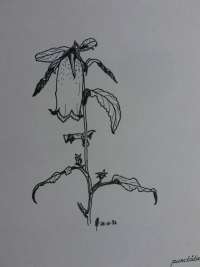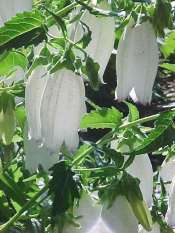Inhoud
punctata
Campanula punctata
Lam.
Infrageneric Taxa
Fam. des Campanulacées. Section 1: Calice accompagné d'appendices foliacés. Groupe 2: - 3 stigmates, capsule á 3 loges1)
Nomenclatuur
* Campanula x VanHouttei Carriere, possibly a hybrid between Campanula latifolia and Campanula punctata; similar to Campanula punctata, but with more tufted habit and darker flowers 2). * Campanula x VanHouttei - Talvolta e chiamata Campanula punctata.3) * Campanula takesimana synonym Campanula punctata
* Campanula punctata (from Mr. William Bull's)4)
Names
E.: Spotted bellflower
J.: Hotaru-bukuro Fr.: V. Campanule noble.5)Herbarium
Breeding
Campanula 'Sarastro' is a clumping, hybrid bellflower (reportedly Campanula punctata x Campanula trachelium) noted for producing deep blue bell-shaped flowers on slowly-spreading, compact plants that typically rise to 20-26” tall and as wide.
Habitus
Coarsely hirsute perennial, short-rhizomatous, sometimes stoloniferous, stems erect,usually simple, 40-80cm long6),( to 2 ½ ft.0, apically branched.
Spotted bellflower is an upright, clump-forming perennial which typically grows 1-2' tall. Stems rise up from basal rosettes of rounded, toothed, medium green leaves (to 5“ long). Long summer bloom. 7) Experimenten in 1958.8)
Leaves
Rosette leaves cordate-ovate, coarsely serrate, stem leaves sessile or winged-petioled, ovate to lanceolate, about 3 in. long.
Basal rosettes of rounded, toothed, medium green leaves(to 5” long).9) Radical leaves ovate-cordate, long-petiolate; cauline leaves deltoid-ovate to broadly lanceolate, acuminate, usually with an abtuse tip, rounded to cuneate at base, irregulary obtuse-toothed, winged-petiolate or sessile.10)Flowers
Flower measuring Campanula punctata vars., over 50mm (2 inches)11)
Flowers nodding, corolla whitish to rose-purple or darker, spotted and flecked purple within, to 2 in. long, tubular-campanulate. Large, drooping, tubular, white to pale pink, bell-like flowers (to 2“ long) with purple inside spotting appear in terminal racemes atop erect to slightly arching stems.12) Calyx-segments linear-lanceolate to deltoid-lanceolate, with a reflexed appendage in the sinus; corolla rose-purple, with dark spots, the lobes rather short, long-ciliate, - June.13)Chromosomes
Number of diploid chromosomes (2n=34).
Fruit
Seed available, in small quantity. Species actually grown or used for breeding 14)
35.00/p.100 Campanulaceae15)
Varieties
* Campanula punctata var. alba
Seed available, in small quantity. Species actually grown or used for breeding 16) 8.00/p.10, 55.00/p.100 Campanulaceae17)
* Campanula punctata var. alviflora ‘Nana Alba’
Campanula punctata cv. 'Pink Chimes' is a hybrid which originated from a cross between Campanula punctata f. alviflora ‘Nana Alba’ (seed parent) and Campanula punctata f. rubiflora ‘Cherry Bells’ (pollen parent).18)* Campanula punctata var. hondoensis - (Kitam.) Ohwi. Synonym: Campanula hondoensis Kitam; Campanula punctata ssp. hondoensis (Kitam.) Kitam. - Hondohotaru-bukuro.
Calyx-segments without a reflexed appendage in the sinuses; corolla deeper colored, slightly spotted; seeds narrowly winged. Mountains; Honshu.19)* Campanula punctata var. microdonta (Koidz.) Ohwi. Synonym: Campanula microdonta Koidz.; Campanula punctata ssp. microdonta (Koidz.) Kitam. - Shimahotaru-bukuro. Less prominently hairy on all parts; flowers smaller, paler in color; calyx-segments with or without a reflexed appendage in the sinuses; seeds nearly wingless. - Near seashores; Honshu (n. and centr. distr. on the Pacific side).20)
* Campanula punctata var. nana
12.00/p.10, 80.00/p.100 Campanulaceae21) * Campanula punctata var. nana alba Flower measuring, between 40 - 50mm (1 1/2 - 2 in.)22) Seed available, in small quantity. Species actually grown or used for breeding 23) 15.00/p.10, 110.00/p.100 Campanulaceae24) * Campanula punctata var. nobilis - Native of Japan. See also Herbarium.* Campanula punctata var. pink form Seed available, in small quantity. Species actually grown or used for breeding 25) * Campanula punctata var. rubriflora
* Campanula punctata var. rubriflora 'Cherry Bells'. The Royal Horticultural Society lists the correct name of Campanula punctata 'Cherry Bells' as Campanula punctata f. rubriflora 'Cherry Bells'. Campanula punctata cv. 'Pink Chimes' is a hybrid which originated from a cross between Campanula punctata f. alviflora ‘Nana Alba’ (seed parent) and Campanula punctata f. rubiflora ‘Cherry Bells’ (pollen parent).26)
Cultivar
* Campanula punctata cv. ‘Bowl of Cherries’
USDA Zone: 3-9. Plant number: 1.110.710. This midsized selection is perfect for the sun or part-shade border. Plants form a spreading mound of light green leaves, bearing upright stems with huge drooping bells in a vibrant purple-pink shade. Clumps are inclined to spread vigorously, so plan to give this space. Deadhead regularly to extend the blooming season. USPP#13194: unlicensed propagation prohibited. Registered with COPF. Sun Exposure; Full Sun or Partial Shade. Soil Type; Normal or Sandy or Clay. Soil pH; Neutral or Alkaline or Acid. Soil Moisture; Average or Moist. Care Level; Easy. Flower Colour; Purple. Blooming Time; Early Summer, Mid Summer, Late Summer. Foliage Color; Light Green. Accent: Good Texture/Form, Border, Containers, Cut Flower, Edging, Rabbit Resistant, Massed Woodland, Flower Head Size; Large. Height; 30-45 cm, 12-18 inches. Spread; 60-75 cm, 23-29 inches. Foot Traffic; None. Growth Rate; Fast.27)
* Campanula punctata cv. 'Cherry Bells'
A spotted bellflower cultivar that features pendulous cherry-red bells (flowers on the Kemper Center plants are dusky rose however). It is an upright perennial which typically grows 1-2' tall. Large, tubular, bell-like flowers (to 2” long) are cherry red with inside spotting. Flowers droop from arching leafy stems over a long late spring to early summer bloom period. Stems rise up from basal rosettes of rounded, toothed, medium green leaves (to 5“ long). The Royal Horticultural Society lists the correct name of this plant as Campanula punctata f. rubriflora 'Cherry Bells'.28)
Moderately hardy. H 50cm not evergreen By Living groundcover-cutting and dry flower rosette-forming - root suckers. The Campanula punctata have larger bells or normal campanulas. Is a very rewarding perennial that early summer erect stems that forms large, cherry-red tubular flowers hang that on the inside strongly mottled. July / Sept.29)
USDA Zone: 3-9. Plant number: 1.110.550. This midsized selection is perfect for the sun or part-shade border. Plants form a spreading mound of light green leaves, bearing upright stems with huge drooping bells in a deep rose-pink shade. Clumps are inclined to spread vigorously, so plan to give this space. Easily divided in spring or fall. Stems may need to be staked. Combines beautifully with Cranesbill Geraniums, Phlox or Hosta. Also excellent in containers or tubs. Sun Exposure; Full Sun or Partial Shade. Soil Type; Normal or Sandy or Clay. Soil pH; Neutral or Alkaline or Acid. Soil Moisture; Average or Moist. Care Level; Easy. Flower Colour; Deep Pink. Blooming Time; Early Summer, Mid Summer, Late Summer. Foliage Color; Light Green. Accent: Good Texture/Form, Border, Containers, Cut Flower, Rabbit Resistant, Massed Woodland, Flower Head Size; Large. Height; 45-60 cm, 18-23 inches. Spread; 60-75 cm, 23-29 inches. Foot Traffic; None. Growth Rate; Fast.30)* Campanula punctata cv. 'Elisabeth' synonym: Campanula takesimana cv. 'Elizabeth'
* Campanula punctata cv. 'Nana'
* Campanula punctata cv. 'Pink' * Campanula punctata cv. 'Pink Chimes' - Dwarf Spotted Bellflower.
A spotted bellflower cultivar that is noted for its pink flowers, strong flowering stems and compact form. It is a hybrid which originated from a cross between Campanula punctata f. alviflora ‘Nana Alba’ (seed parent) and Campanula punctata f. rubiflora ‘Cherry Bells’ (pollen parent). Plants typically grow to 12” tall and to 15” wide.
Large, tubular, bell-like flowers (to 2” long) are pink with reddish-purple inside spotting. Flowers droop from arching leafy stems over a long late spring to early summer bloom period. Stems rise up from basal rosettes of toothed, ovate-cordate, medium green leaves (to 2” long). U. S. Plant Patent PP13,156 issued October 29, 2002. Campanula comes from Latin and means little bell.
Borders, rock gardens, cottage gardens, lightly shaded woodland settings or naturalized areas. Group or mass for best effect. Strong stems make this a good container plant. Easily grown in average, medium moisture, well-drained soil in full sun to part shade. Prefers some part shade in hot summer climates. Does not perform well in summer climates where night temperatures consistently remain above 70 degrees F. Needs regular moisture. Divide clumps in fall every 3-4 years. In mild summer climates, plants may rebloom in summer if spent flower stems are clipped back immediately after flowering. May spread freely by rhizomes under optimum growing conditions.
USDA Zone: 3-9. Plant number: 1.110.560. This compact selection is perfect for the sun or part-shade border and containers. Plants form a spreading mound of light green leaves, bearing upright stems with large, dangling cherry-pink bells, spotted on the inside. Clumps are inclined to spread vigorously, so plan to give this space. Attractive when mass-planted as a groundcover, or for a border edging. Remove faded flowers regularly to promote repeat blooming. USPP#13156: unlicensed propagation prohibited. Registered with COPF. Sun Exposure; Full Sun or Partial Shade. Soil Type; Normal or Sandy or Clay. Soil pH; Neutral or Alkaline or Acid. Soil Moisture; Average or Moist. Care Level; Easy. Flower Colour; Deep Pink. Blooming Time; Early Summer, Mid Summer, Late Summer. Foliage Color; Light Green. Accent: Good Texture/Form, Border, Containers, Cut Flower, Edging, Rabbit Resistant, Ground Cover Massed, Woodland. Flower Head Size; Medium. Height; 30-40 cm, 12-16 inches. Spread; 40-60 cm, 16-23 inches. Foot Traffic; None. Growth Rate; Fast.31)
* Campanula punctata cv. 'Rubra'
Plant type: Perennial. Use: In groups. Height 50-90 cm. Flower color: Pink-purple. Flower Period: June and August. Light: sun, partial shade. humidity: Acidity: Neutral. Maintenance: Pruning after first flowering. Details: cut flower.32)
Origin
East Siberia, north Japan.
Grassy slopes in lowlands and low mountains; Hokkaido, Honshu, Shikoku, Kyushu; common.33)Benefit
Borders, rock gardens, cottage gardens, lightly shaded woodland settings or naturalized areas. Group or mass for best effect. Easily grown in average, medium, well-drained soil in full sun to part shade. Prefers part shade in hot summer climates. Does not do well when night temperatures do not cool down below 70 degrees F. Needs regular moisture. Divide clumps in fall every 3-4 years. Spreads freely by both rhizomes and self-seeding under optimum growing conditions.34)
























